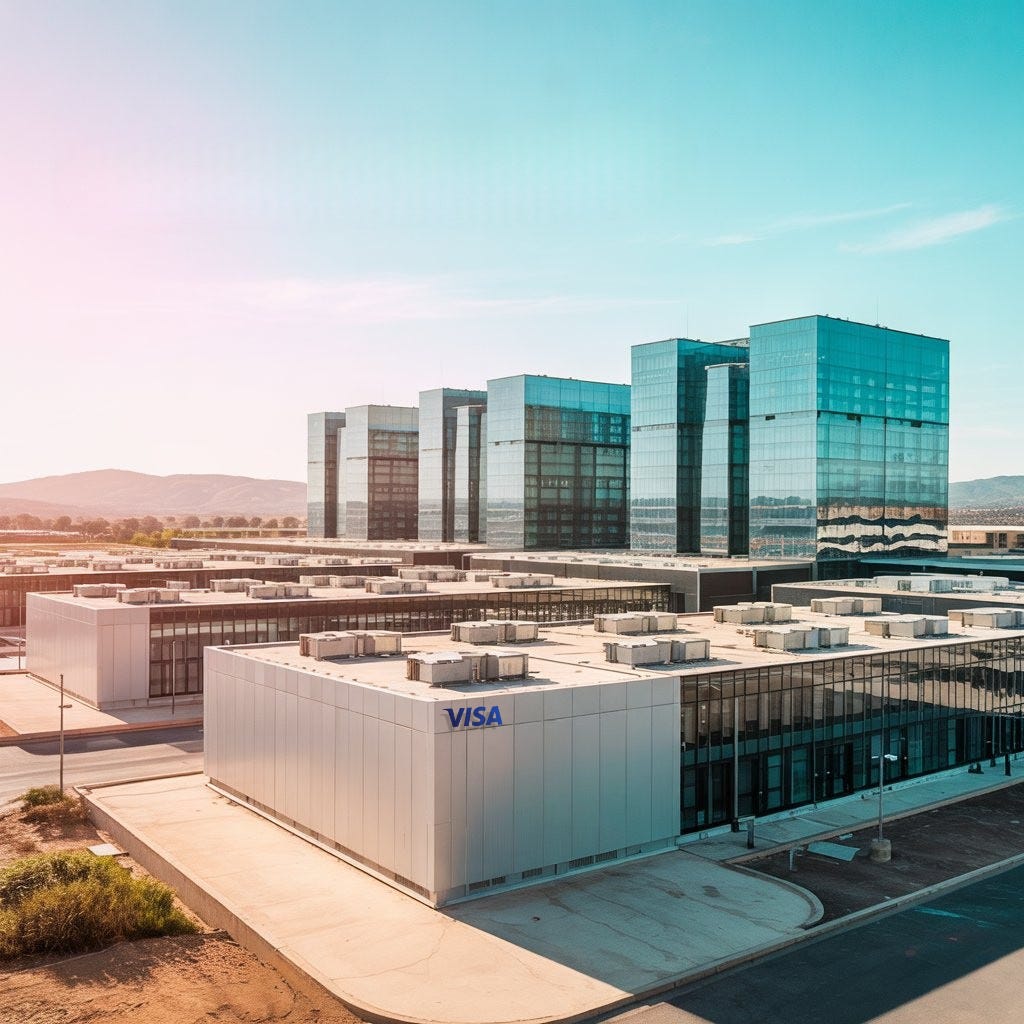Is Visa Building a Financial Fortress in Africa?
How Visa’s new Johannesburg data center turns compliance into competitive advantage and positions Africa at the heart of global fintech infrastructure.
Welcome to Global Data Center Hub. Join 1800+ investors, operators, and innovators reading to stay ahead of the latest trends in the data center sector in developed and emerging markets globally.
Visa’s new $57M data center in South Africa isn’t just a technical upgrade. It’s a power move.
On July 23, 2025, Visa quietly flipped the switch on its first African data center.
No splashy ad campaign. No global press tour.
Just a new sovereign-grade facility in Johannesburg designed to process African transactions locally, comply with a rising tide of data regulations, and anchor Visa’s ambitions for the next billion digital users.
But this isn’t just a nice-to-have for Visa.
It’s the linchpin of a much bigger game.
Visa’s setup mirrors a broader trend where firms recognize that infrastructure isn’t just an afterthought it’s a foundational competitive edge, as we’ve discussed in “How Shared Digital Infrastructure Can Bridge The Gap in Africa”
A Bet on Two Powerful Forces
Visa’s data center strategy is driven by two converging trends:
A $1.5 trillion opportunity
Africa’s digital payments economy is projected to explode by 2030. Mobile money, contactless payments, and e-commerce are already reshaping how people move money.The new battleground: Data sovereignty
Governments across Africa South Africa, Nigeria, Kenya are pushing for local data processing. Compliance is no longer optional. It's a ticket to compete.
Rather than see this as a burden, Visa turned it into a moat.
They didn’t lobby to delay. They built ahead of the curve.
Johannesburg: Not Just a Location, a Signal
Visa’s decision to place this facility in Johannesburg is no accident.
Yes, the city anchors Africa’s most developed data center market.
Yes, it’s already home to hyperscale deployments from AWS, Microsoft, Teraco, and Equinix.
But those are surface reasons.
At its core, this move reflects something deeper: South Africa is the credibility gateway to the African continent. A country with a track record of:
financial innovation,
rapid fintech adoption, and
strong government backing for digital transformation.
This facility isn’t a trial run. It’s a statement.
Visa is no longer treating Africa as an emerging opportunity it's building for it as a foundational layer of its global infrastructure strategy.
Infrastructure Is the Strategy
Most global companies invest in Africa through partnerships.
Visa is laying cable and concrete.
Here’s what the Joburg facility unlocks:
Reduced latency: Faster transactions and smoother UX for both fintechs and consumers.
Improved reliability: Less dependence on overseas routing = fewer failed payments.
Regulatory advantage: Visa can now offer compliance as a service—especially in markets pushing for local data rules.
Local trust: Physical presence builds credibility with banks, governments, and regulators.
In other words: Visa’s not just building a data center.
It’s building a financial fortress.
This vertical integration model aligns with what investors now expect new KPI frameworks targeted at emerging hubs, as outlined in Evaluating Data Center Performance Metrics: Key KPIs for Investors, where uptime and adaptability increasingly outweigh traditional metrics.
A Platform Play, Not a Point Solution
The Johannesburg facility is just one layer of Visa’s three-tier Africa strategy:
Tier 1: Infrastructure – Local processing via the new data center
Tier 2: Innovation – Visa’s Fintech Accelerator backing startups from Ghana to Tunisia
Tier 3: Integration – Strategic deals with players like Moniepoint, Chipper Cash, and OkHi
This is a vertically integrated platform strategy, designed not just to process transactions, but to shape the very companies that generate them.
And with every fintech that builds on VisaNet, the value of its infrastructure compounds.
The Risk (and Why It’s Worth It)
Building a data center in South Africa isn’t risk-free.
The country faces persistent energy instability. Load shedding is real.
But Visa, like AWS and Microsoft before it, is betting on workarounds: private generation, solar back-up, diesel redundancy.
Why take the risk?
Because it’s easier to solve for energy than it is to rebuild trust, talent, and connectivity elsewhere.
In Visa’s calculus, the strategic upside far outweighs the operational drag.
What This Means for Competitors
Mastercard now faces a simple but urgent question:
Where’s your African data center?
As sovereign compliance becomes a non-negotiable requirement, global players relying on European or U.S. infrastructure will find themselves increasingly shut out of major African markets.
Even local upstarts with mobile money platforms may struggle to match Visa’s new combination of low-latency, high-compliance infrastructure.
Visa didn’t just build a facility.
It built leverage.
Final Thought: The Next Decade Will Be Decided by Infrastructure
We talk a lot about who controls AI models, cloud platforms, or digital currencies.
But we talk too little about who controls the rails.
Visa’s Johannesburg data center is a reminder that infrastructure isn’t a lagging indicator of innovation it’s a leading one.
The companies that win in Africa’s fintech boom will be those who invested early in physical capacity, local compliance, and ecosystem integration.
Visa just put its flag in the ground.
And it’s not going anywhere.

